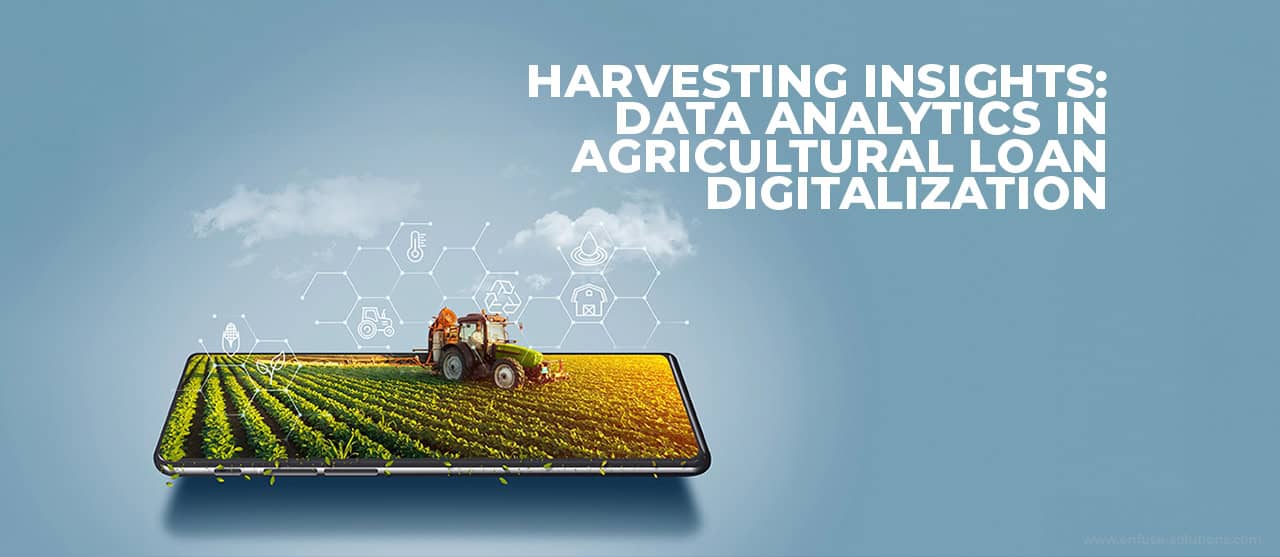
Technological progress has changed how businesses operate, and this is also true for the farming sector. Now farmers and lenders can use digital tools and analyze data to make better choices, which results in more efficiency and profitability.
In the field of agricultural lending, this new development has greatly influenced how things work. Through using data analysis, lenders can better understand their client’s financial health and performance. At the same time, farmers find improved options for getting loans.
In this blog, we examine the function of data analysis in making agricultural loans digital and its impact on transforming the field of farming.
The Scope Of Data Analytics In Agriculture
The growing significance of data analytics in farming is clear, especially considering the United Nations’ prediction that by 2050 the world’s population will grow to around 9.7 billion people, which means there will be a substantial increase of 33% more people needing food. Farmers are beginning to apply data analytics as a crucial method for improving agricultural practices to manage the challenge of feeding many additional individuals.
Industry leaders with a long history and new start-ups are both very important in making solutions that use data to increase productivity and help farmers connect more with their crops. The numbers show that the market for farm analytics around the world is expected to grow a lot, from $1.4 billion in 2023 to $2.5 billion by 2028, which means it will get bigger at an annual rate of 13.1%.
North America is now the biggest market, but it’s also important to see how quickly Asia-Pacific is growing as a new big player — highlighting the widespread and diverse significance of data analytics for the future of agriculture. Let’s take a look at the role of data analytics, specifically with respect to agricultural loans.
Role Of Data Analytics In Agricultural Loan Digitalization
1. Data Collection And Integration
To start turning agricultural loans into digital form, we need to gather and combine different pieces of data. Traditionally, people have been writing out their loan requests by hand, which took a lot of time and often led to mistakes. Through data analytics, the procedure is quicker and more precise now.
Farmers can apply for loans on the Internet, with their information being gathered automatically and added into the system. This not only saves time but also eliminates the risk of human error. Additionally, integrating data lets lenders see the borrower’s financial condition completely. They can obtain details about the credit past, earnings, spending, and possessions of the borrower, aiding them in making knowledgeable choices on the loan.
2. Predictive Analytics For Risk Assessment
Loans for farming are seen as risky because the industry is not stable. If something unexpected like bad weather or crop failure happens, the person who borrowed money might not be able to pay it back. Hence, predictive analytics assists lenders in evaluating the risk linked to every loan application.
Predictive analytics employs past data to find patterns and trends, assisting in forecasting the probability of loan defaults. Lenders use this data to make better choices on approving or denying a loan application and setting the interest rate and terms for the loan.
3. Improving Decision-Making With Descriptive Analytics
Descriptive analytics takes past information to give understanding and find places where the lending method can be improved. Banks can look at information from previous loan applications to see what elements make for successful repayment and which cause loans not to be paid back. This data aids banks in making choices based on facts for loan conditions, interest levels, and who can get loans. It also helps them see red flags or dangers tied to some people borrowing money.
Benefits And Opportunities
1. Enhanced Risk Management
Farmers and those working in agriculture regularly deal with uncertainties like natural disasters, changing prices, and shifts in climate. These make loans for farming quite risky. Analyzing tools that work with data can support the people who give out loans to assess the danger of every loan request by looking at information on soil conditions, climate trends, and previous loan records. It helps them to decide better about giving loans, which leads to reduced loan defaults and improved profit margins.
2. Increased Efficiency In Loan Approval Processes
Data analysis is very important for making the process of approving loans faster and easier. By using special techniques like predictive modeling and machine learning, lenders can examine a lot of information from applications quickly to see trends and decide what to do. This makes the process of getting a loan approved quicker, so farmers can receive funds sooner. Also, making the loan application digital cuts down on mistakes and fraud, which means that loans are assessed more correctly.
3. Financial Inclusion In Agriculture
As farmers in distant places can now use smartphones and the Internet, they can now access banking services and improve their chances of getting loans. Lenders use data analysis to understand if these farmers are good for lending money to them without needing physical papers or assets in hand. Access to loans for small farmers has gotten better and people in the rural areas have learned more about managing money.
Challenges And Concerns
1. Data Quality And Availability
Loan providers must have high-quality, complete information about agriculture to make correct and dependable choices. This kind of information is not always easy to find because it can be spread out over different places and in many forms. Also, the information might not be complete or correct, which makes it hard for those who give loans to properly check if farmers and agricultural companies are good for getting credit.
2. Cost And Access To Technology
A big worry about using data analytics for digital agricultural loans is how much money it takes and the ease of getting technology. It can cost a lot to start these tools and systems, especially for small or rural banks. Moreover, there might be a shortage of technical skills and resources to use these tools and systems properly. This can lead to a gap between the bigger, financially solid organizations and the smaller ones in terms of digital capacity.
3. Resistance To Change
Many banks find it hard to start using data analysis and digital ways because both the lenders and farmers often don’t want to change. Those banks might not want to try new technologies, especially when they have used old methods for many years.
Moreover, farmers and agricultural businesses might resist moving towards digital methods because they could be not used to technology or might like dealing with loan officers face-to-face better. This resistance to change can hinder the adoption and effectiveness of digital loan processes in the agricultural sector.
Conclusion
The integration of data analytics empowers stakeholders to harvest actionable insights and cultivate a more prosperous future for agriculture worldwide as we navigate the complexities of feeding a growing population and fostering economic prosperity within the agricultural community.
Is your business prepared to transform itself with data-driven decisions? EnFuse Solutions, a prominent autonomous provider, presents an all-encompassing range of diverse outsourced professional and managed services, endowing your business with a distinct advantage.
Elevate your decision-making capabilities through our cutting-edge digital analytics and decision support services, covering digital market research, social media analytics, sentiment analytics, campaign analytics, tagging design & implementation, omnichannel analytics, and social listening.
Our tailored analytics solutions are crafted to capture high-quality data, resolve gaps, and automate reporting processes, empowering you to make informed decisions tied to specific desired outcomes. Take the first step towards transforming your business — contact us to get started on your journey to data-driven success.

















Comment